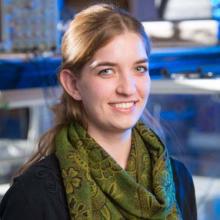Dr. Katherine (Niessen) Lindberg
The extent of the role of protein vibrational motions on protein function has been a long-standing question in the biophysical community. The functional relevance of these vibrations has been predicted through calculations, however, direct measurement of these vibrational motions has proven to be challenging. Here, I present my work on a newly developed technique, Anisotropy Terahertz Microscopy (ATM), for determining intramolecular protein vibrations. This technique is a major advance over previous methods as it reveals the directionality of the vibrational displacements. Measurements of chicken egg white lysozyme (CEWL) are presented as a function of inhibitor binding and show dramatic changes in directionality of motion. Computational techniques based on normal mode analysis and quasiharmonic analysis were developed and tested for comparison to measurements. These calculations reveal the inadequacies in the simulation methods, but reveal an overall agreement with the measurements in that the directionality of the protein vibrations changes drastically with binding, while the energy distribution of the vibrations shows only minor changes. The functional significance of the change in the vibration directionality with functional state was further studied through additional calculations of a functionally favorable mutation of CEWL. These also show large changes in the vibration directionality with binding, with no significant changes to the energy distribution when compared to the wild-type system, signifying that the mutation may be steering the vibration directionality such that the function is enhanced. I also present several measurements performed for the improvement of measurement detection and imaging quality in terahertz microscopy methods. To reduce measurement times and systematic variations from the measurement process, I present measurements and simulations of an alternative technique, Polarization-Varying ATM (PV-ATM), which shows enhanced spectral features. Measurements and simulations on the model system sucrose reveal that this enhanced sensitivity is the product of the polarization dependence of the new measurement technique and the birefringence within the sample. Measurements on the binding dependence of CEWL samples show large changes in the spectra with binding, supporting the previous results. I then present supporting simulations to an improved technique, Ideal PV-ATM, which maintains the advantages of the PV-ATM method, while reducing the sensitivity to the sample birefringence. The spectral features are anticipated to be more similar to the initial ATM measurements and more straight-forward for analysis, as predicted by simulations of the model system sucrose.
|
LinkedIn | ResearchGate | Google Scholar
|
||||
